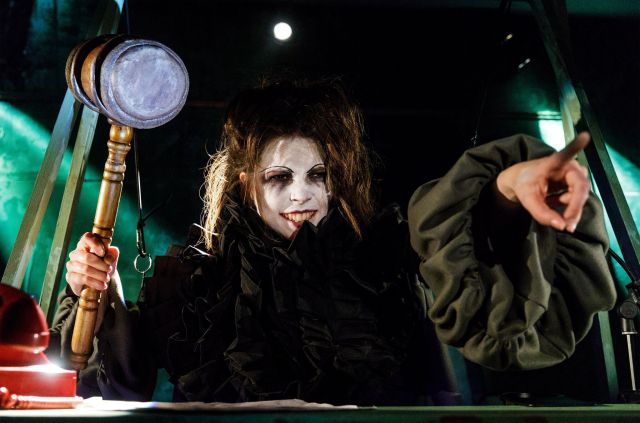Inside Pussy Riot, Saatchi Gallery review - an immersive misfire | reviews, news & interviews
Inside Pussy Riot, Saatchi Gallery review - an immersive misfire
Inside Pussy Riot, Saatchi Gallery review - an immersive misfire
Promenade piece makes hyperactive theatrical weather of some important themes

You say you want a revolution? Good luck locating one amid the tonally muddled Inside Pussy Riot.
The location allows the audience to travel through a series of rooms representing various stages of Tolokonnikova's ordeal, from the initial protest itself as staged in a Day-Glo cathedral packed with gleaming stained glass Trumps, Putins and Murdochs through to solitary confinement in a darkened cell. The all-female ensemble bring Berkoff-style grotesquerie (pictured below) to the deliberately exaggerated portraits of police officers, prison wardens and the like. The performance style is one of large gestures, stylised poses and declamatory speeches. Zoe Koperski's design keeps pace, blending bright pastels with nightmarish pantomime scenarios to create a garish world that matches the prevailing hyperactivity. The confident direction is by Christa Harris, while Tolokonnikova shares a co-writing credit with Oliver Lansley. But whereas Tolokonnikova's imprisonment highlighted the oppression inherent in Putin's Russia (and catapulted Pussy Riot into the global consciousness), the seriousness of the topic here sometimes slips from view. Early on, an audience member is pressured to undress, challenging notions of culpability and solidarity, but to what end? (Discretion forbids me from saying more about the "reveal", so to speak, of this particular segment.) The audience, handed balaclavas at the start, are constantly reminded that they are in an interactive performance even as they are mocked for following instructions. After a while, one loses sight of who or what is being sent up. The Russian state? A public that would partake of such an event in one of London's most moneyed boroughs? Meta-theatre itself?
But whereas Tolokonnikova's imprisonment highlighted the oppression inherent in Putin's Russia (and catapulted Pussy Riot into the global consciousness), the seriousness of the topic here sometimes slips from view. Early on, an audience member is pressured to undress, challenging notions of culpability and solidarity, but to what end? (Discretion forbids me from saying more about the "reveal", so to speak, of this particular segment.) The audience, handed balaclavas at the start, are constantly reminded that they are in an interactive performance even as they are mocked for following instructions. After a while, one loses sight of who or what is being sent up. The Russian state? A public that would partake of such an event in one of London's most moneyed boroughs? Meta-theatre itself?
A later scenario finds Tolokonnikova's emotive diary entries read aloud, only to be drowned out by a second performer bellowing orders at the crowd. Not for the first time the over-egged style obscures the subject matter: there's an urgent message here that, unlike Tolokonnikova herself, never quite breaks free.
The future of Arts Journalism
You can stop theartsdesk.com closing!
We urgently need financing to survive. Our fundraising drive has thus far raised £49,000 but we need to reach £100,000 or we will be forced to close. Please contribute here: https://gofund.me/c3f6033d
And if you can forward this information to anyone who might assist, we’d be grateful.

Subscribe to theartsdesk.com
Thank you for continuing to read our work on theartsdesk.com. For unlimited access to every article in its entirety, including our archive of more than 15,000 pieces, we're asking for £5 per month or £40 per year. We feel it's a very good deal, and hope you do too.
To take a subscription now simply click here.
And if you're looking for that extra gift for a friend or family member, why not treat them to a theartsdesk.com gift subscription?
more Theatre
 Hedda, Orange Tree Theatre review - a monument reimagined, perhaps even improved
Scandinavian masterpiece transplanted into a London reeling from the ravages of war
Hedda, Orange Tree Theatre review - a monument reimagined, perhaps even improved
Scandinavian masterpiece transplanted into a London reeling from the ravages of war
 The Assembled Parties, Hampstead review - a rarity, a well-made play delivered straight
Witty but poignant tribute to the strength of family ties as all around disintegrates
The Assembled Parties, Hampstead review - a rarity, a well-made play delivered straight
Witty but poignant tribute to the strength of family ties as all around disintegrates
 Mary Page Marlowe, Old Vic review - a starry portrait of a splintered life
Tracy Letts's Off Broadway play makes a shimmeringly powerful London debut
Mary Page Marlowe, Old Vic review - a starry portrait of a splintered life
Tracy Letts's Off Broadway play makes a shimmeringly powerful London debut
 Little Brother, Soho Theatre review - light, bright but emotionally true
This Verity Bargate Award-winning dramedy is entertaining as well as thought provoking
Little Brother, Soho Theatre review - light, bright but emotionally true
This Verity Bargate Award-winning dramedy is entertaining as well as thought provoking
 The Unbelievers, Royal Court Theatre - grimly compelling, powerfully performed
Nick Payne's new play is amongst his best
The Unbelievers, Royal Court Theatre - grimly compelling, powerfully performed
Nick Payne's new play is amongst his best
 The Maids, Donmar Warehouse review - vibrant cast lost in a spectacular-looking fever dream
Kip Williams revises Genet, with little gained in the update except eye-popping visuals
The Maids, Donmar Warehouse review - vibrant cast lost in a spectacular-looking fever dream
Kip Williams revises Genet, with little gained in the update except eye-popping visuals
 Ragdoll, Jermyn Street Theatre review - compelling and emotionally truthful
Katherine Moar returns with a Patty Hearst-inspired follow up to her debut hit 'Farm Hall'
Ragdoll, Jermyn Street Theatre review - compelling and emotionally truthful
Katherine Moar returns with a Patty Hearst-inspired follow up to her debut hit 'Farm Hall'
 Troilus and Cressida, Globe Theatre review - a 'problem play' with added problems
Raucous and carnivalesque, but also ugly and incomprehensible
Troilus and Cressida, Globe Theatre review - a 'problem play' with added problems
Raucous and carnivalesque, but also ugly and incomprehensible
 Clarkston, Trafalgar Theatre review - two lads on a road to nowhere
Netflix star, Joe Locke, is the selling point of a production that needs one
Clarkston, Trafalgar Theatre review - two lads on a road to nowhere
Netflix star, Joe Locke, is the selling point of a production that needs one
 Ghost Stories, Peacock Theatre review - spirited staging but short on scares
Impressive spectacle saves an ageing show in an unsuitable venue
Ghost Stories, Peacock Theatre review - spirited staging but short on scares
Impressive spectacle saves an ageing show in an unsuitable venue
 Hamlet, National Theatre review - turning tragedy to comedy is no joke
Hiran Abeyeskera’s childlike prince falls flat in a mixed production
Hamlet, National Theatre review - turning tragedy to comedy is no joke
Hiran Abeyeskera’s childlike prince falls flat in a mixed production
 Rohtko, Barbican review - postmodern meditation on fake and authentic art is less than the sum of its parts
Łukasz Twarkowski's production dazzles without illuminating
Rohtko, Barbican review - postmodern meditation on fake and authentic art is less than the sum of its parts
Łukasz Twarkowski's production dazzles without illuminating

Add comment